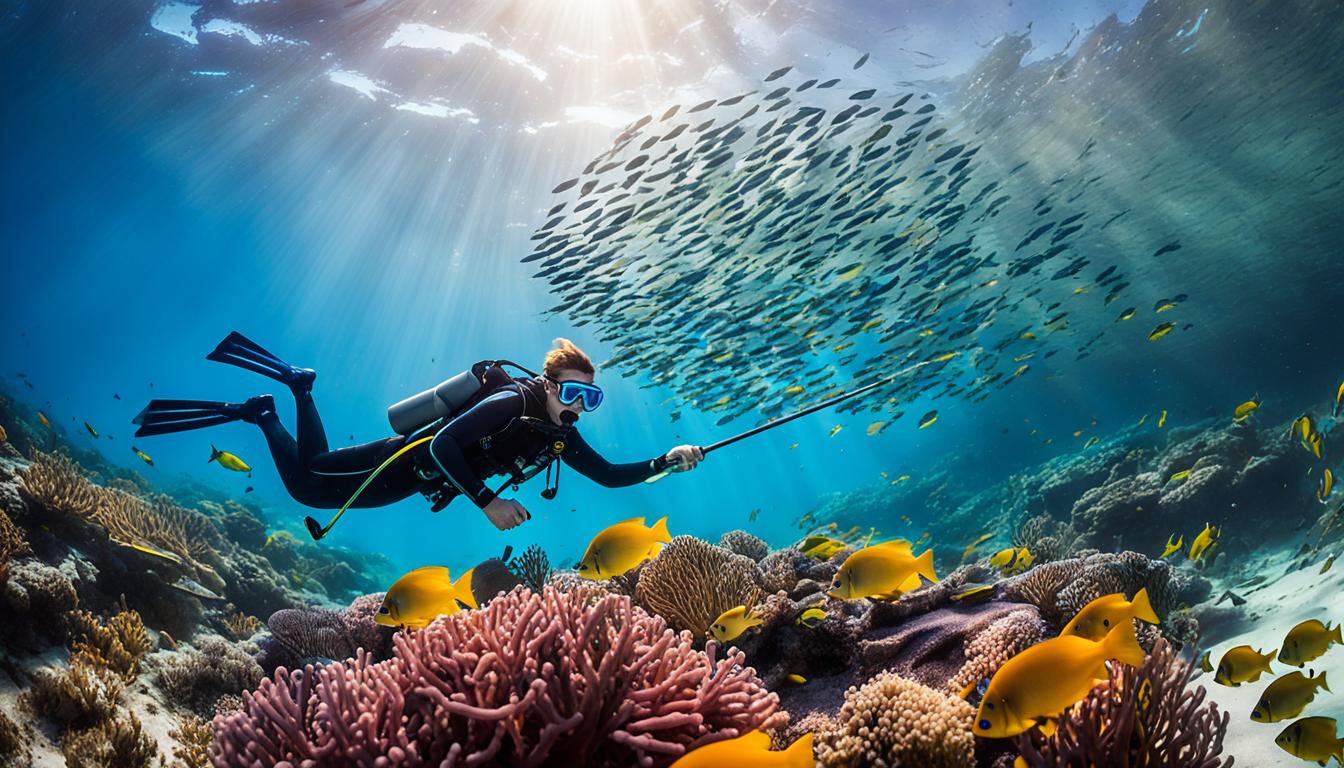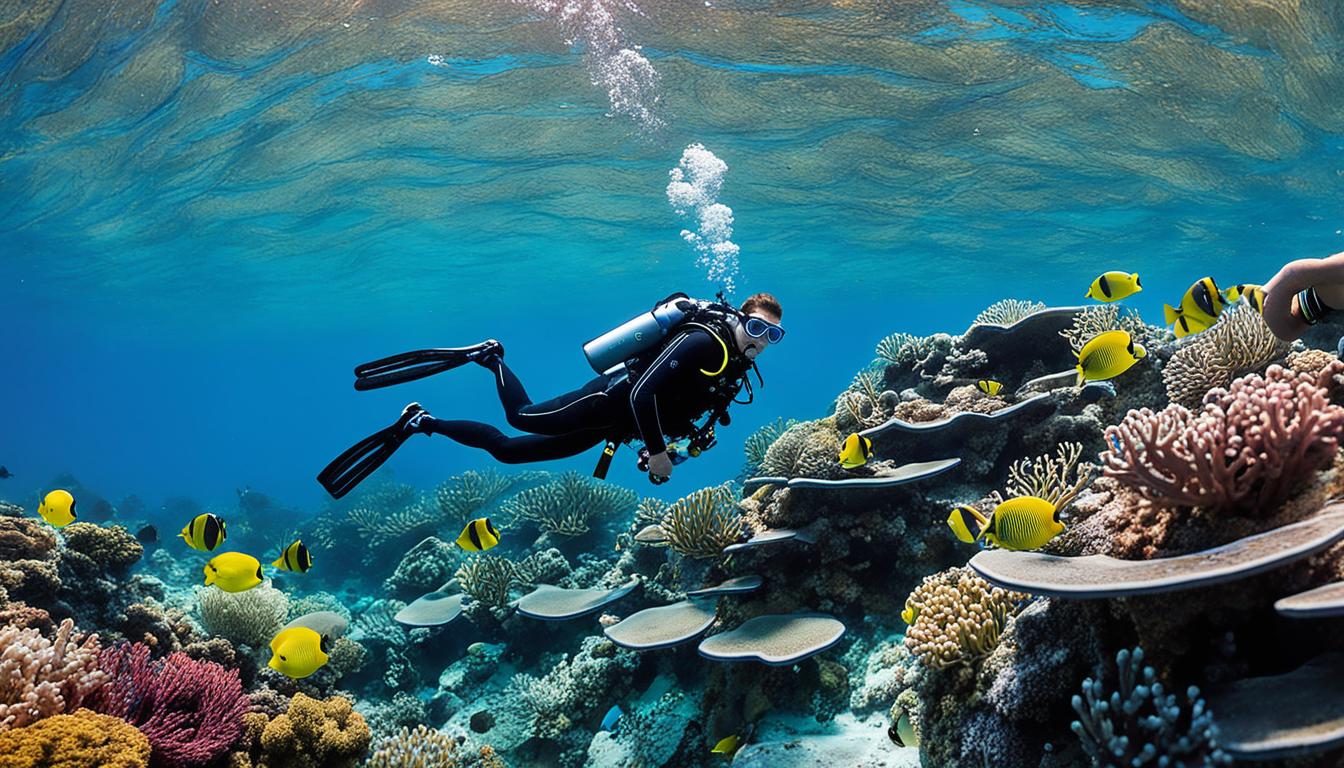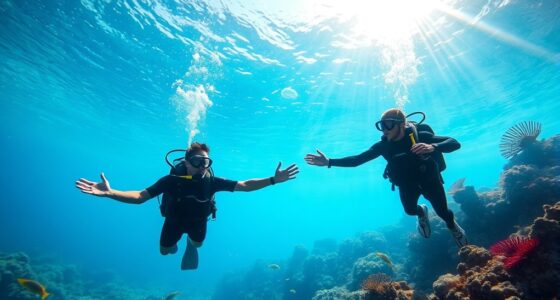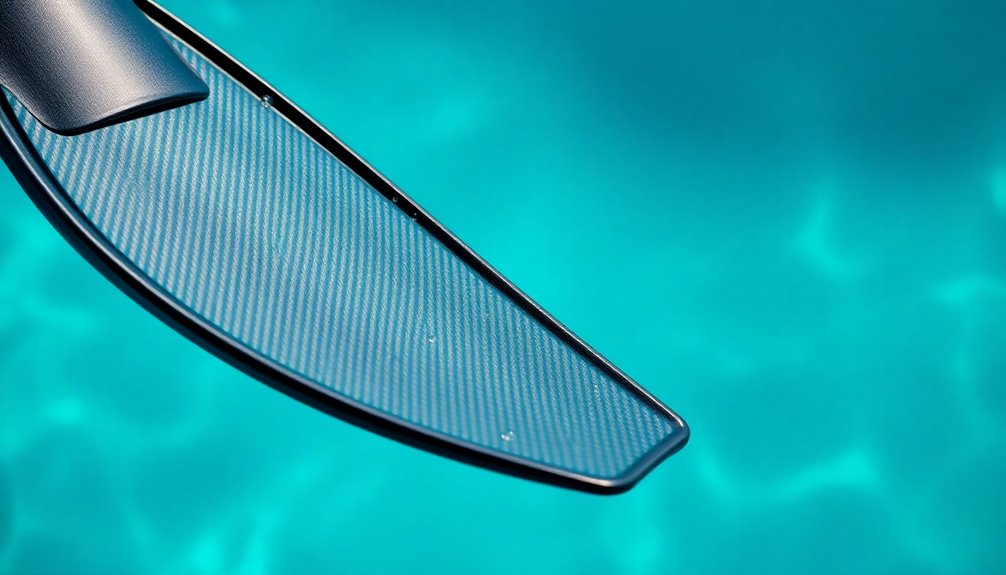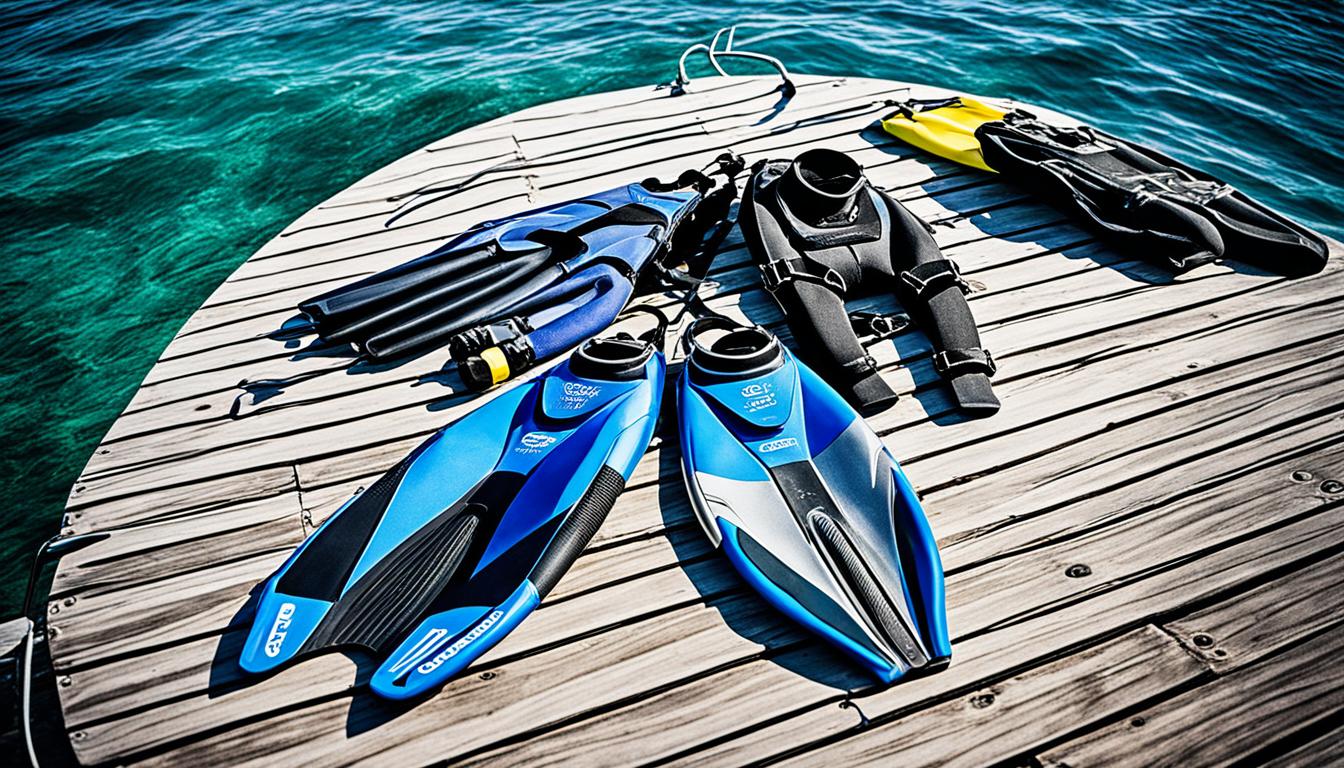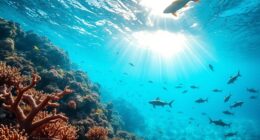Spearfishing is a thrilling sport that combines hunting and fishing underwater. Whether you’re a beginner or a seasoned spearfisherman, Western Australia offers some of the best spearfishing spots in the world. In this ultimate guide, we will cover everything you need to know about spearfishing in WA, including the gear you’ll need, the techniques to master, and the regulations you must follow.
Key Takeaways:
- Western Australia offers over 50 spearfishing locations for enthusiasts.
- North-Western sites like Broome and Exmouth provide diverse spearfishing opportunities.
- Depth ranges from 1m-15m in the North-Western region, suitable for experienced divers.
- Geraldton is known for its rich reef and diverse marine life, but caution is necessary due to the presence of Great White Sharks.
- Southern regions like Perth and Albany have notable spearfishing spots, emphasizing the importance of caution with the prevalence of Great Whites.
How to Use This Spearfishing Guide
Welcome to our comprehensive guide to spearfishing in Western Australia! Whether you’re a novice or experienced spearfisherman, this guide will provide you with all the information you need to get started or enhance your skills. Here’s how to make the most of this beginner’s guide:
- Read from start to finish: If you’re new to spearfishing, we recommend reading this guide in chronological order. This will give you a solid foundation of knowledge and gradually introduce you to the different aspects of spearfishing.
- Jump to specific topics: If you’re already familiar with certain aspects of spearfishing or have specific questions, feel free to jump straight to those sections. Simply click on the relevant links in the table of contents or use the navigation menu at the top of each page.
- Take notes and bookmark: As you read through the guide, take notes on important tips, techniques, and regulations. You can also bookmark specific pages for future reference.
- Refer back as needed: Spearfishing is a skill that requires practice and ongoing learning. You can always refer back to this guide whenever you need a refresher or want to explore new techniques.
Throughout this guide, you’ll find valuable information on sustainable fish species, regulations, gear recommendations, diving techniques, and much more. We want to ensure you have a safe and enjoyable spearfishing experience while also protecting marine ecosystems. Keep in mind that spearfishing regulations may vary by location, so always check local laws and guidelines before diving.
Tips for Beginners
“Before you even think about carrying a speargun, take the time to observe and become comfortable in the water. Familiarize yourself with the waves, currents, and marine life around you. This will help you develop essential water skills and increase your chances of a successful spearfishing trip.” – Expert Spearfisherman
Remember to pace yourself, especially if you’re a beginner. It’s important to take things one step at a time and gradually build up your skills and experience. Spearfishing can be physically demanding, so be sure to listen to your body and take breaks when needed.
Now that you know how to navigate this guide, let’s dive into the basics of spearfishing in the next section!
Spearfishing Basics
Before embarking on your spearfishing journey, it’s crucial to familiarize yourself with the basics. This section will provide you with essential knowledge and skills to enhance your spearfishing experience. From understanding the different types of spearfishing to mastering safety precautions, here’s everything you need to know to get started.
Types of Spearfishing
Spearfishing can be practiced in various environments, including freshwater lakes, rivers, and saltwater oceans. Each setting offers unique challenges and opportunities. In WA, freshwater spearfishing is limited to targeting carp, as they are the only freshwater fish open for this activity. On the other hand, saltwater spearfishing destinations like Baja are renowned for their abundant marine life and diverse fish species.
Skills and Safety Precautions
Like any water sport, spearfishing requires specific skills and safety measures to ensure a successful and safe outing. Here are some key considerations:
- Diving with a buddy is advised to mitigate the risks associated with shallow-water blackouts, which can happen to anyone.
- Always observe state regulations and creel limits to maintain a positive reputation and protect the local fishing community.
- Wearing a wetsuit is recommended, especially in non-tropical areas where a thickness of 2-3mm is ideal to prevent hypothermia.
- Utilize cut-resistant gloves and a stringer to handle your catch safely.
- A slip tip spear is suggested as a more secure option compared to a 3-prong pole spear when targeting fish.
Observation and Techniques
Successful spearfishing requires a combination of observation, patience, and breath-holding techniques. Understanding fish behavior and adapting your approach accordingly can significantly increase your chances of a successful hunt. Spend time observing your target species and their habitat, practice breath-holding exercises to enhance your lung capacity for longer dives, and develop the patience needed to wait for the perfect moment to strike.
Remember to respect the environment and follow sustainable practices. Spearfishing is a thrilling activity that allows you to connect with nature in a unique way. By adhering to regulations, protecting the ecosystem, and continuously improving your skills, you can contribute to the preservation of this ancient sport.

Gear You’ll Need
Having the right gear is essential for a successful spearfishing trip. When it comes to spearfishing gear in WA, there are a few essential items you’ll need to ensure a safe and productive experience.
Spearfishing Essentials
- Speargun: The primary tool for capturing fish underwater, a speargun allows for accurate shots and is available in a variety of styles and sizes to suit different skill levels and target species.
- Snorkel and Mask: A comfortable snorkel and mask set is crucial for clear vision and efficient breathing while exploring the underwater world.
- Fins: Choose fins that provide the right balance of power and maneuverability. They should fit snugly to your feet and be comfortable for long dives.
- Wetsuit: The selection of a spearfishing wetsuit depends on the water temperature. Opt for a thickness ranging from 0.5 to 3 mm gauge to ensure comfort and protection.
- Weight Belt: Maintaining neutral buoyancy is vital in spearfishing. A weight belt helps you counteract the buoyancy of your wetsuit, allowing for better control and stability in the water.
- Dive Knife: A dive knife comes in handy for cutting yourself free from tangled lines or kelp and can be a valuable tool in emergency situations.
These essential pieces of spearfishing gear will equip you for a successful adventure in the waters of WA. However, there are also some optional gear that can enhance your experience: Items such as a dive watch, float line, and underwater camera can provide added safety and help you capture unforgettable moments. Additionally, researching **Whitsundays spearfishing hotspots** can guide you to prime locations known for their rich marine life. While not mandatory, these extra tools and knowledge can elevate your spearfishing journey to the next level.
- Spearfishing gloves, made of materials like Kevlar, offer protection for your hands and ensure a secure grip on your equipment.
- A dive computer or watch is a beneficial device, aiding in tracking dive times, depth, and even monitoring your heart rate.
Remember, safety is paramount in spearfishing. It is advisable to dive with a partner or in a group, and always use a “diver down” flag to alert other vessels to the presence of divers underwater.
Now that you’re equipped with the essential spearfishing gear, it’s time to explore the different types of spearguns and choose the one that best suits your needs.
Types of Spearguns
Choosing the right speargun is essential for a successful spearfishing experience. There are several types of spearguns available, each with its own advantages and disadvantages. Let’s explore the different options:
Pole Spears
Pole spears are simple and straightforward, making them a popular choice for beginners. They consist of a long, rigid pole with a spear tip attached to the end. Pole spears are lightweight and easy to maneuver, making them ideal for targeting small fish in close-range situations. However, they have a limited range and may require more precision when aiming.
Hawaiian Slings
Hawaiian slings are another beginner-friendly option. They feature a pole with a rubber loop or sling attached to one end. By pulling back on the sling and releasing it, you can propel the spear towards your target. Hawaiian slings offer a longer range than pole spears and are relatively lightweight. They are versatile and suitable for various fishing environments.
Pneumatic Spearguns
Pneumatic spearguns use compressed air to power the spear. They are compact and lightweight, making them highly maneuverable underwater. Pneumatic spearguns have a higher shooting range and penetration capabilities, making them suitable for larger fish. The shaft diameter typically ranges around 0.31 inches (8 mm), allowing for effective fish penetration.
Band-Powered Spearguns
Band-powered spearguns use rubber bands to propel the spear. They offer different levels of power depending on the number of bands used. Band-powered spearguns are versatile and widely used by experienced spearfishers. The shaft diameter of these spearguns ranges between 0.26 and 0.28 inches (6.5 mm to 7 mm), which provides flexibility and accuracy. However, they are more prone to bending when targeting larger prey and have shorter shooting ranges compared to pneumatic spearguns.
European vs. American Spearguns
When considering spearguns, it’s important to note the differences between European and American designs. European spearguns are lightweight and equipped with slim shafts, making them ideal for catching small fish at close ranges. They are known for their maneuverability in tight spaces. On the other hand, American spearguns are designed with thicker shafts and provide more power, making them suitable for hunting larger game fish. However, they may be more cumbersome to handle underwater.
It’s essential to consider factors such as your skill level, target fish species, and fishing environment when choosing a speargun. Consulting with experienced spearfishers and professionals will help you make an informed decision.

| Speargun Length | Recommended Use |
|---|---|
| 19.7 to 29.5 inches (50 cm to 75 cm) | Tight spaces, increased maneuverability |
| 31.5 to 45 inches (80 to 115 cm) | Shallow water and reef spearfishing, balance between short and long-range shots |
| 47 to 63 inches (120 cm and 160 cm) | Deep, open water hunting of big game fish, enhanced power and speed for longer distances |
Remember, the type of speargun you choose will greatly impact your overall spearfishing experience. Take the time to research and test different options to find the one that best suits your needs and abilities.
Intro to Freediving
Freediving is an essential skill for those who want to excel in spearfishing. It allows you to explore the underwater world with grace, precision, and a deep connection to nature. In this section, we will introduce you to the basics of freediving and explain why it is the preferred method for spearfishing enthusiasts.
When you engage in freediving, you rely on your own breath-holding abilities to dive underwater. This is in contrast to scuba diving, which requires the use of breathing apparatus. Freediving offers a more intimate and immersive experience, allowing you to move silently through the water and approach marine life in their natural habitat.
One of the key skills you will develop in freediving is breath control. By mastering breathing techniques, you can extend your time underwater and explore greater depths. Proper equalization techniques are also essential to protect your ears and sinuses as you descend.
During your freediving training, you will learn relaxation exercises to calm your body and mind. This is crucial for conserving oxygen and increasing your ability to dive deeper. Mental training will also play a significant role, as it allows you to overcome any fears or anxieties associated with diving.
At our Perth, Western Australia location, we offer a range of freediving courses suitable for all levels. Whether you are new to the sport or an experienced diver, our courses cater to your needs and goals. Our Try Freediving course is perfect for beginners, allowing you to experience the thrill of freediving at a depth of 5 meters.
If you are ready to take your skills to the next level, our Level 1, Level 2, and Level 3 courses provide comprehensive training and certification. These courses cover essential skills such as equalization techniques, relaxation exercises, mental training, safety protocols, rescue skills, body position techniques, and breath work.

Spearfishing is one of the activities catered to in our freediving courses. By combining the skills of freediving with spearfishing, you can hunt for fish in an ethical and sustainable way. Freediving allows you to get closer to your target fish without scaring them away, increasing your chances of a successful catch.
Our courses have flexible durations, ranging from 3 to 5 days, depending on the level of training. We have affordable pricing options, with our Try Freediving course starting at $300 and our advanced Level 3 course priced at $1200.
Each year, we certify hundreds of students who have successfully completed our freediving courses. Our experienced instructors are passionate about sharing their knowledge and helping you become a skilled freediver.
Join us for an unforgettable journey into the world of freediving and spearfishing. Discover the beauty and thrill of exploring the underwater realm, and unlock your full potential as a freediver.
Benefits of Freediving for Spearfishing
The combination of freediving and spearfishing offers numerous benefits for those who love the sport. Here are some key advantages:
- Closer Encounters: Freediving allows you to approach fish discreetly, getting closer than ever before. This enhances your chances of a successful hunt and provides a more intimate connection with the underwater world.
- Improved Stealth: Without the noise and bubbles associated with scuba gear, freedivers can move silently underwater, avoiding detection by fish and increasing their chances of a successful catch.
- Enhanced Fitness: Freediving is a physically demanding activity that improves lung capacity, breath control, and overall cardiovascular fitness. Regular freediving sessions will help you become a stronger and more confident diver.
- Ecological Responsibility: Freediving for spearfishing promotes sustainable fishing practices. By targeting specific species and hunting within legal limits, you can contribute to the preservation of marine ecosystems.
Spearfishing from the Surface
When it comes to spearfishing, the technique of spearfishing from the surface is a popular choice among enthusiasts. This method allows divers to hunt fish in shallow waters while utilizing snorkeling equipment. Whether you’re a beginner or an experienced spearfisherman, surface spearfishing can be a thrilling and rewarding experience.
One of the advantages of spearfishing in shallow water is the visibility. While underwater visibility can vary, being closer to the surface often offers better visibility compared to deeper waters. This means you can easily spot your targeted fish and plan your approach accordingly.
Neah Bay and La Push, located on the Pacific Northwest coast, are renowned destinations for surface spearfishing. These areas offer various activities for spearfishermen, but it’s important to note that a Neah Bay Recreation Permit is required, costing $20, for engaging in these activities.
During your surface spearfishing expedition, you’ll encounter a diverse range of fish species, including Kelp Greenling, Black Rockfish, perch, Cabezon, Vermillion Rockfish, Sea Bass, and jellyfish. It’s essential to familiarize yourself with fishing regulations in the area, as certain species may be off-limits or have specific restrictions. For example, black and blue rockfish are open for fishing in the Strait of Juan de Fuca.
When it comes to spearfishing in areas with heavy kelp, safety should be a top priority. Using a rubber weight belt, ensuring the release stays in front for easy access, and opting for smaller guns for easier maneuvering are some of the safety tips to consider. Utilizing closed heel fins while freediving in dense kelp environments can also enhance your safety and maneuverability.

While exploring the underwater world, it’s important to be mindful of potential risks. For instance, encounters with Gray Whales feeding in close proximity can raise safety concerns. In such cases, it’s advisable to swim back towards the shore until it’s safe to resume your dive. The spearfishing community actively engages in discussions around fish species protection under the Endangered Species Act, emphasizing responsible fishing practices and respecting the ecosystem.
Organizations like the Divers Alert Network (DAN) provide valuable safety resources and information for spearfishers, offering courses that are essential for both novice and experienced practitioners. Additionally, spearfishing clubs and organizations in Washington play a pivotal role in fostering a culture of learning, respect for the ocean, and environmental awareness. They organize educational workshops, guided dives, and community events, creating opportunities for spearfishermen to connect and share their knowledge.
Community events and competitions not only strengthen bonds among spearfishing enthusiasts but also showcase their skills and highlight the importance of sustainability and ethical practices. This collective effort ensures the preservation of marine habitats and the long-term well-being of fish populations.
As a traditional and environmentally friendly alternative to spear guns, the use of pole spears is gaining popularity among Washington spearfishers. Pole spears allow for selective targeting and reduced impact on non-targeted species, aligning with the principles of sustainable fishing.
Collaboration between spearfishing communities and marine conservation organizations in Washington is essential to safeguarding marine habitats, monitoring fish populations, and implementing effective conservation measures such as marine protected areas. These efforts are crucial in advocating for sustainable fishing regulations that balance the needs of spearfishers and the preservation of our oceans.
| Fish Species | Size/Weight |
|---|---|
| Kelp Greenling | 18″ | 2.6 pounds |
| Black Rockfish | Varies |
| Perch | Varies |
| Cabezon | Varies |
| Vermillion Rockfish | Varies |
| Sea Bass | Varies |
| Jellyfish | Varies |
Locating Fish for Spearfishing
When it comes to spearfishing, one of the most crucial skills to master is locating fish. Whether you’re a seasoned diver or a beginner, understanding fish hunting techniques and finding fish for spearfishing can significantly improve your chances of a successful catch. In this section, we will explore various strategies and insights to help you hone your fish-finding abilities and increase your chances of a fruitful dive.
Experienced divers have shared valuable insights on diving depths for spearfishing. They have reported catching lingcod and other fish species at relatively shallow depths of 10-30 feet. Additionally, anecdotal evidence suggests that fish, such as halibut and lings, can be found in as little as 6 feet of water. These findings emphasize that depth itself is not the sole determining factor for coastal fishing success. Instead, paying attention to appropriate terrain, habitat, and the behavior of the fish becomes critical.
There are specific diving spots, such as Neah Bay, where lingcod and rockfish are abundant. Divers have reached their catch limits in waters no deeper than 30 feet, showcasing the potential for successful spearfishing at shallower depths. Understanding the habits and patterns of the fish in these areas can give you a significant advantage when locating fish during your spearfishing adventures.
While locating fish is essential, safety should always be a top priority. Spearfishing practices should always be conducted with caution. It’s crucial to have a diving partner on the surface to ensure your safety. Being aware of currents, carrying a readily accessible knife, and practicing situational awareness can greatly reduce potential risks during your dives.
Encountering Substantial Fish Species
Divers have shared exciting encounters with sizable lingcod, some weighing up to 50 pounds, in relatively shallow waters like the Edmonds dive park. The presence of these substantial fish species within accessible diving depths demonstrates the potential for memorable spearfishing experiences even without venturing into deeper waters.
It’s important to note that unsustainable spearfishing practices in shallow waters can have negative consequences for fish populations. Historical accounts highlight the harm caused to lingcod populations when nesting females were targeted in depths of 30 feet or less. Conservation efforts and responsible spearfishing practices are crucial to preserve the delicate balance of marine ecosystems and sustain fish populations for future generations of spearfishers.
Within the spearfishing community, there is a remarkable level of engagement and enthusiasm. Participants in online discussions express their interest in spearfishing and willingly share photos of their catches. This vibrant community is filled with avid divers who are passionate about the sport and eager to exchange knowledge and experiences.
As you embark on your spearfishing adventures, it’s important to consider the logistics. Some diving locations may require a 90-minute drive, so plan your trips accordingly. For safety and visibility purposes, it is recommended to use a rigid or hard float while spearfishing. It’s also advisable to have a whistle and a reflective device on hand for emergencies. Carrying a fully equipped first aid kit and undergoing a 15m (50ft) floatline apprenticeship are additional safety measures to enhance your diving experience.
Gear Considerations
When it comes to gear, using robust fins for shore diving is essential. Avoid spending excessive amounts of money on expensive fins that may not provide significant advantages. Keep in mind that boots are prone to wearing out quickly, so it’s a common expense to consider in your spearfishing endeavors.

Spearfishing Techniques
Mastering different spearfishing techniques is essential for success in the sport. By utilizing these advanced spearfishing techniques, you can increase your chances of a successful dive and enhance your overall experience. In this section, we will explore various techniques that will help you become a more proficient spearfisherman.
Accurate Shooting
Accurate shooting is one of the foundational techniques in spearfishing. It involves developing precise aim and timing to ensure a clean and effective shot. By honing your shooting skills, you can minimize the risk of injuring the fish and improve your chances of a successful harvest.
Stalking
Stalking is a technique that requires patience, stealth, and observation. By carefully approaching your target without alerting it to your presence, you can position yourself for a well-placed shot. Stalking is particularly effective in clear water conditions where visibility is high, allowing you to get closer to the fish without spooking it.
Ambush Hunting
Ambush hunting involves strategically positioning yourself in an area where fish are likely to pass by. By waiting patiently and blending with the surroundings, you can take advantage of the fish’s natural behavior and surprise them with a swift and accurate shot. This technique is especially effective for targeting ambush predators like pike.
Shooting in Low Visibility
Shooting in low visibility conditions, such as murky water or low light, requires special techniques. By relying on your other senses, such as touch and sound, you can compensate for the decreased visibility and still make accurate shots. Practice adjusting your shooting style in these conditions to maintain your effectiveness as a spearfisherman.
Shot Placement
Shot placement is crucial when spearfishing to ensure a quick and humane kill. Understanding the anatomy of the fish you are targeting and knowing where to aim is essential. Aim for the head or the vital organs to increase the likelihood of an effective shot and minimize unnecessary suffering for the fish.
Retrieving and Securing the Speared Fish
After a successful shot, retrieving and securing the speared fish is an important skill to master. This includes properly handling the fish to prevent injury to yourself or damage to the equipment. It’s also essential to be mindful of potential entanglement risks and avoid any unnecessary damage to the surrounding environment.
By incorporating these advanced spearfishing techniques into your diving adventures, you can elevate your skills and increase your chances of a successful and rewarding spearfishing experience.
| Techniques | Description |
|---|---|
| Accurate Shooting | Develop precise aim and timing for clean and effective shots. |
| Stalking | Approach targets stealthily and position yourself for well-placed shots. |
| Ambush Hunting | Strategically position yourself to surprise fish as they pass by. |
| Shooting in Low Visibility | Adapt your shooting style to compensate for low visibility conditions. |
| Shot Placement | Target vital organs for a quick and humane kill. |
| Retrieving and Securing the Speared Fish | Properly handle and secure the fish after a successful shot. |

Recovering and Caring for Fish
Proper fish handling and care after spearfishing are essential for both the sustainability of fish stocks and the quality of the catch. Here, we will discuss the techniques and precautions you should take when retrieving and handling speared fish, as well as the proper methods for cleaning, filleting, and storing the fish.
Retrieving Fish
Once you’ve successfully speared a fish, it’s important to handle it carefully to avoid damaging the flesh or compromising its quality. Use a landing net or a stringer to secure the fish and prevent it from swimming away. Avoid dropping the fish on hard surfaces or dragging it across the ground, as this can cause bruising or injuries.
Handling Fish
When handling fish, be mindful of the delicate nature of their scales and skin. Wet your hands before touching the fish to minimize the removal of the protective slime layer. This layer helps the fish stay healthy and protects it from infection. Support the fish with both hands and avoid squeezing or putting excessive pressure on its body.
Cleaning and Filleting
Cleaning and filleting the fish properly is crucial to ensure its freshness and taste. Start by rinsing the fish with clean water to remove any dirt or debris. Use a sharp knife to make clean cuts along the body, removing the head, tail, and entrails. If you’re unsure how to fillet a fish, there are plenty of online tutorials and resources available to guide you through the process.
Storage and Preservation
After cleaning and filleting the fish, it’s important to store it properly to maintain its quality. Place the fillets in airtight containers or zip-lock bags and store them in a cooler with ice or in a refrigerator. Avoid leaving the fish exposed to warm temperatures for extended periods, as this can lead to spoilage.
Remember, it’s vital to follow local regulations regarding fish possession limits and seasonal closures. These guidelines are in place to protect fish stocks and ensure their sustainability for future generations of spearfishers. By responsibly handling and caring for fish after spearfishing, you contribute to the preservation of our marine ecosystems and the enjoyment of the sport for years to come.

Is Spearfishing Dangerous?
Spearfishing is an exhilarating sport that has gained significant popularity in recent years, thanks in part to thrill-seekers sharing their underwater exploits online. However, like any water sport, there are risks associated with spearfishing. It’s essential to be aware of these risks and take the necessary precautions to ensure your safety while enjoying this sport.
One of the primary safety concerns in spearfishing is diving-related injuries. It’s crucial to be well-versed in the rules and regulations of spearfishing, including size and possession limits, weather conditions, and the use of safety equipment. Fisheries Queensland recommends diving in pairs for safety reasons, as having a buddy can provide assistance in case of emergencies.
Encounters with marine life, particularly sharks, are another potential risk. Although shark attacks on spearfishermen are relatively rare, there have been two reported incidents off the coast of Lucinda in North Queensland in the past seven years. It’s important to be knowledgeable about the behavior of marine animals and take necessary precautions to minimize the risk of encounters with aggressive species.
An unfortunate example of the dangers associated with spearfishing is the tragic death of Australian snowboarder Alex “Chumpy” Pullin in 2020. He suffered a shallow-water blackout while spearfishing on the Gold Coast. This incident highlights the importance of proper training and awareness of the risks involved in breath-holding activities.
To minimize the risks, spearfishers are advised to adhere to specific zones where spearfishing is permitted, and regulations dictate size and bag limits for various fish species. Additionally, the mandatory display of dive flags by spearfishers in the water aims to reduce the risk of accidents and ensure a safer environment for all.
Despite the risks involved, some spearfishers view the sport as a sustainable alternative to line fishing, promoting selective targeting and adherence to legal catch limits. It’s important to remember that spearfishers have a role to play in marine conservation. By participating in conservation initiatives such as beach clean-ups and supporting marine ecosystem research projects, spearfishers in Western Australia are actively contributing to the preservation of marine environments.
Overall, spearfishing can be a thrilling and rewarding activity, but it’s essential to prioritize safety and be well-educated about the risks involved. By following the rules and regulations, being aware of potential dangers, and taking necessary precautions, you can enjoy a safe and enjoyable spearfishing experience.
Scuba Diving and Spearfishing
While spearfishing traditionally involves freediving, some spearfishermen opt to combine scuba diving with their sport. Scuba spearfishing presents a different approach to underwater hunting, offering both advantages and disadvantages compared to freediving. Let’s explore the world of scuba diving and spearfishing.
Scuba diving allows spearfishermen to access greater depths and spend longer periods underwater. This extended bottom time increases the chances of encountering larger game fish that inhabit deeper waters. With scuba equipment providing a constant supply of air, divers have the opportunity to patiently wait for their target and take more precise shots.
On the other hand, scuba spearfishing has its drawbacks. The presence of scuba gear can create additional noise and bubbles, potentially alarming fish and making them more difficult to approach. The use of scuba equipment also restricts maneuverability, making it harder to navigate through underwater terrain and hunt efficiently.
One of the growing trends in scuba spearfishing is the targeting of invasive species like lionfish. Lionfish have no natural predators in certain regions, causing significant harm to native fish populations. Scuba spearfishermen actively contribute to the control of these invasive species by hunting lionfish and helping to restore ecological balance.
Scuba diving and spearfishing can provide unique opportunities to explore deeper waters and actively participate in preserving marine ecosystems. It’s important to remember that responsible fishing practices should always be followed, regardless of the diving method used.
“Spearfishing allows divers to connect with the underwater world in a way that no other sport does. Whether you choose freediving or scuba diving, it’s crucial to prioritize sustainable fishing practices and respect for marine life.”
Comparison of Freediving and Scuba Diving in Spearfishing
| Aspect | Freediving | Scuba Diving |
|---|---|---|
| Depth Access | Limited to breath-hold capabilities | Allows access to greater depths |
| Bottom Time | Dependent on breath-hold duration | Extended due to continuous air supply |
| Maneuverability | Excellent | Slightly restricted by scuba gear |
| Noise and Bubbles | Minimal, allowing for stealthy approach | Potentially alarming to fish |
| Ecological Contribution | Controlling invasive species | Controlling invasive species |

Both freediving and scuba diving have their merits in spearfishing. It ultimately comes down to personal preference, diving experience, and the specific goals of each individual. Before engaging in scuba spearfishing, proper training and certification are crucial to ensure safety and proficiency in handling the equipment.
Ultimately, whether you choose to freedive or scuba dive, responsible fishing practices should always be a top priority. By practicing sustainable fishing, respecting marine life, and contributing to conservation efforts, spearfishermen can play their part in preserving the delicate balance of our oceans.
Conclusion
Spearfishing in Washington offers a thrilling and rewarding experience for both beginners and experienced spearfishermen. With its rich variety of fish species, including lingcod, halibut, and various rockfish, the waters of Washington are a prime location for spearfishing enthusiasts. The data from the Washington Department of Fish and Wildlife highlights the abundance and diversity of marine life in the region, making it an ideal destination for underwater adventures.
To ensure a safe and responsible spearfishing experience, it’s essential to prioritize safety and follow local regulations. Organizations like the Divers Alert Network (DAN) provide valuable safety resources and courses for spearfishers in Washington, equipping them with the knowledge they need to stay safe while enjoying their hobby.
Spearfishing clubs and organizations in Washington play a crucial role in educating the community on sustainable spearfishing practices and marine conservation. Through community events and competitions, they strengthen bonds within the spearfishing community, fostering a culture of mentorship and sustainability. Many spearfishers in Washington actively participate in conservation efforts, promoting catch-and-release practices and engaging in marine conservation projects to protect the fragile marine ecosystems.
As spearfishing continues to grow in popularity, it’s important to remember the impact it can have on marine life and ecosystems. By advocating for sustainable fishing methods, collaborating with marine conservation organizations, and respecting the environment, spearfishers in Washington can contribute to the protection of marine habitats and the advocacy for sustainable fishing regulations. So, gear up, dive in, and embark on an unforgettable spearfishing journey in the beautiful waters of Washington!

